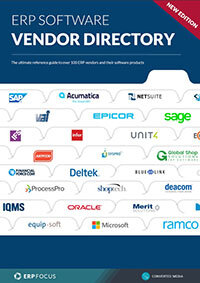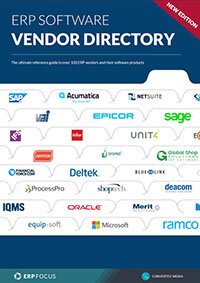Five things to consider when implementing a medical device ERP
The medical device industry represents one of the fastest growing manufacturing sectors in the United States. In fact, Espicom Business Intelligence projects the US market will maintain a compound annual growth rate of 5.3% for 2014-2019, leading to annual revenues of $173.3 billion by 2019.
Manufacturers will find that many general enterprise resource planning (ERP) best practices also apply to the medical device industry. However, several national initiatives focused on device cost, availability, the patient’s treatment experience, and tracking of long-term outcomes present unique challenges for device manufacturers implementing ERP systems.
Following are five issues that medical device manufacturers will need to address with their ERP systems if they are to thrive in this rapidly expanding, but highly regulated industry.
1. A strong device history record is key
Many industry executives and entrepreneurs are medical practitioners or engineers focused on patient outcomes, not manufacturability or costs. Therefore, manufacturers developing new devices need strong recordkeeping via a device history record (DHR) that demonstrates a sound technical concept, patient benefit, attention to cost of materials and production, and long-term results. Building a DHR that ensures a successful design and FDA compliance, requires an ERP system that incorporates document management, engineering bill of materials (BOM), planned process routing, cost estimating, and failure modes and effects analysis (FMEA).
2. A single ERP database ensures consistency and efficiency
The FDA is working with the Centers for Medicare and Medicaid Services (CMS) to enable the concurrent review of device designers’ applications to shorten the development, application, field test, FDA and payment approval processes. Mistakes and misunderstandings due to disparate software tools can cause costly delays in time to market. So it is more important than ever to assure that business processes are efficient and built on a common database managed by the ERP system.
Recommended reading: find a medical ERP to suit your needs with our completely up-to-date ERP vendor directory.
3. Project insight and time-to-market can make or break a medical startup
According to the US Department of Commerce, more than 80% of medical device companies have fewer than 50 employees, and many of these businesses, particularly start-ups, have little or no sales revenue for years since development and approval timeframes can run a decade or longer. At the same time, entrepreneurs’ funding sources are tightening as capital shifts to lower risk industries.
Therefore, a capable ERP system with integrated engineering, purchasing, accounting and project management is critical for medical device firms. This provides the needed visibility into overall financials, R&D costs, project milestones, and status of agency filings to manage the “burn rate” of funding and assure investors that risk is being minimized. Additionally, integration between a computer-aided design (CAD) platform and the ERP system’s engineering records can accelerate design and development work while minimizing the risk of errors in key product data.
4. There is virtually no tolerance for errors
In the medical device industry, even a minor problem can put the brakes on FDA approval or spark a major recall. Yet any manual transfer of information from one software system to another raises the risk of errors and omissions. That’s why even medical device or component manufacturers with relatively small sales volumes can benefit by integrating smart planning, quality control, and manufacturing execution tools with the ERP system. Through automated sharing of the critical production, inventory and quality data, manufacturers gain real-time insights that minimize the risk of product errors.
Integrating modern manufacturing systems with ERP software can also error-proof the production process set-up. Under this methodology, the system prevents production from starting until the operator is presented with correct work instructions and confirms that the specified material, correct tooling, right packaging and labels are all present.
Then, as the work order is produced, the operator should conduct quality checks with calibrated gauges and instruments to ensure that statistical process control (SPC) is updated consistently. For quality assurance, consider using affordable smart sensors and automation software to automate process monitoring and predict potential quality problems and equipment failures before they happen.
These closed-loop systems can alert technicians of an impending issue, so they can quickly plan downtime to prevent disruptions in production or, worse, undetected product quality problems. With medical devices, it’s imperative to have an ERP system that alerts and then helps to prevent future issues using the corrective and preventive action (CAPA) methodology.
Using software tools to manage production quality can have strong financial benefits. For example, one medical device components maker reported that keeping tabs with these tools led to a 50% reduction in scrap material and $36,000 annual savings in overtime costs.
5. Track and trace for fast reporting
The FDA’s intense efforts to protect patient safety can result in surprise audits, product safety investigations, and recall actions. An ERP system optimized for medical device manufacturing needs “track and trace” reporting. This functionality enables fast, accurate extraction of material certifications and process traceability records to support any inquiry from a customer or regulatory agency—while limiting the scope of the investigation to only those products in question.
By implementing an ERP system that addresses the five requirements outlined here, manufacturers will be well positioned to balance the demands of medical device costs, availability, patients’ short- and long-term treatment experiences, quality assurance, and strict regulatory compliance. In doing so, they can unlock the keys to thriving in the high-growth, highly competitive medical device sector.
Free white paper

ERP Software Vendor Directory
Put the most comprehensive ERP vendor directory on your desk today

Featured white papers
-

ERP Software Pricing Guide
Get the latest pricing information on over 80 popular ERP systems, and learn how to budget for your ERP project in our free guide
Download -

ERP Implementation: 9 steps to success
The 9 proven steps you should follow when implementing ERP
Download -

ERP Implementation Checklist
Over 120 actionable steps to implementing a new ERP successfully
Download
Related articles
-

The case for multi-tier ERP implementations
Learn more about multi-tier ERP implementation and why you might need one
-

Secret KPI: Why Your ERP Implementation Team Matters More Than Software
Learn how Godlan ensures successful ERP implementation for manufacturers with proven strategies &...
-

An example ERP implementation team structure for your project
Learn about three key elements of an ERP implementation team and the individuals who contribute w...

